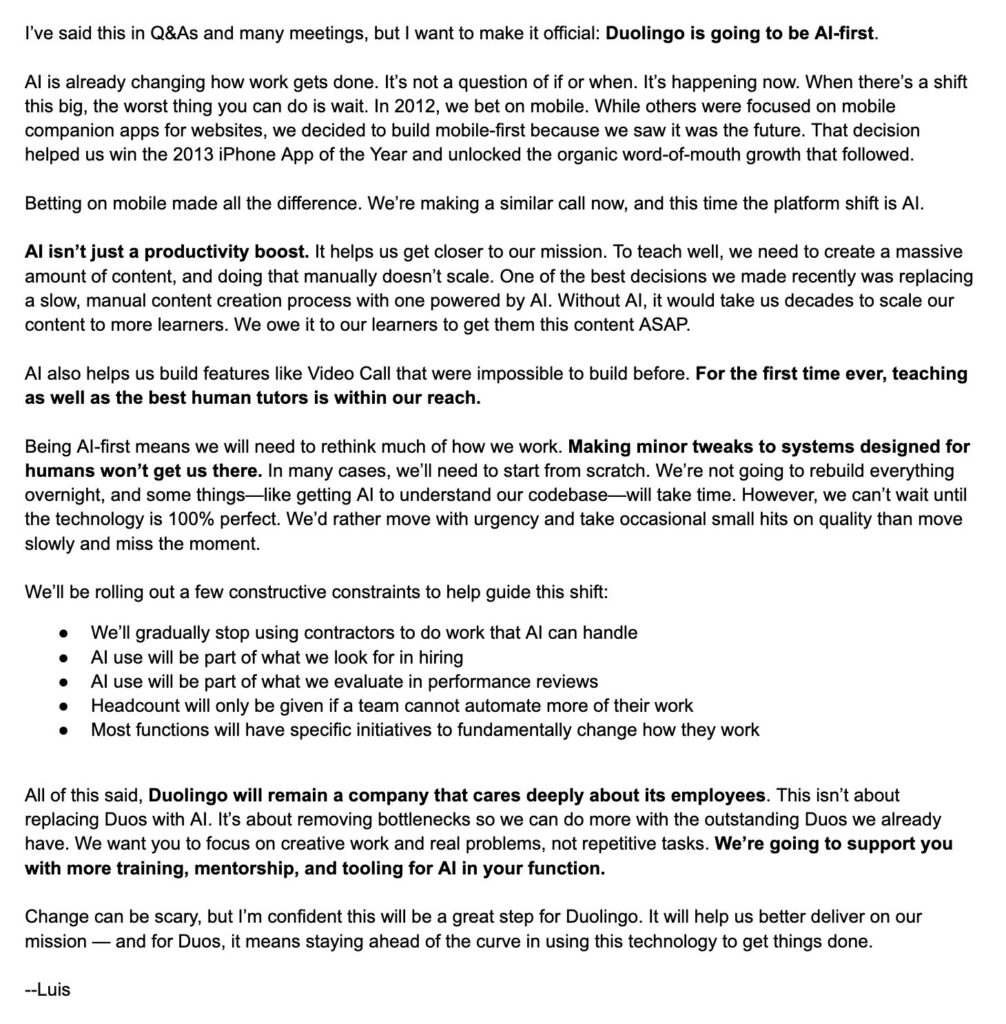Coincidence? Duolingo cuts contractors same week Google launches AI Tiny Lessons
The language education world is changing fast, and it’s not good news for contractors
This week, two big things happened that could affect your work if you’re a language educator: Google launched “Tiny Lessons,” which uses AI to teach languages, and Duolingo decided to put AI first, meaning they’re cutting back on contractors.
Google’s New AI Tool: “Tiny Lessons”
Google’s Tiny Lessons is a new set of AI tools for learning languages. Google says it uses its Gemini AI to give personalised lessons. The tools include:
Tiny Lesson: AI gives you the words and grammar you need for specific situations
Slang Hang: AI creates conversations to help you learn how people really talk
Word Cam: You point your camera at something, and AI tells you the words for it
Google says these tools are meant to help with language learning, not replace teachers. However, when a giant like Google gets into language learning with AI, it’s a sign that things are changing.
Duolingo chooses “AI-First”, cuts contractors
Duolingo is taking a different approach. They’re going “AI-first,” which means they’re using AI to do more of the work. This means they’re getting rid of a lot of their contract workers if AI can do the same tasks, according to Duolingo’s boss, Luis von Ahn.
Basically, von Ahn is saying they’re putting AI ahead of human contractors anywhere it can be justified. As he said in a memo to employees, which was posted in part on the company’s LinkedIn page: “AI is already changing how work gets done… When there’s a shift this big, the worst thing you can do is wait.”
He also stated that Duolingo will “gradually stop using contractors to do work that AI can handle”.
They say this will make things better, but it’s worrying for anyone who makes a living teaching languages.
Luis von Ahn’s message, which was posted on DuoLingo’s LinkedIn page:

Faster AI course creation = fewer contractors
One of the reasons contractors will be cut from Duolingo is that course content development is being replaced by AI and “shared content” (whatever that means).
Historically, building a single new course on Duolingo could take years. Through advances in generative AI, shared content systems, and internal tooling, the company said in April, it has created and launched a suite of 148 courses in less than a year. Duolingo’s new approach, known internally as “shared content,” enables the team to “create a high-quality base course and quickly customise it for dozens of different languages.”
Luis von Ahn, CEO and co-founder of Duolingo, said in a statement on April 30th, “Developing our first 100 courses took about 12 years, and now, in about a year, we’re able to create and launch nearly 150 new courses. This is a great example of how generative AI can directly benefit our learners.”
“This launch reflects the incredible impact of our AI and automation investments, which have allowed us to scale at unprecedented speed and quality.”
Changes mean a mixed bag for language professionals
Wouer de Jong, an English as a Second Language Teacher, responded to Duolingo’s new direction in a LinkedIn post that while Duolingo may save a lot of money on contractor fees, it’s looking more like “AI first, customer second.”
Alper Cizmeci, a Games Developer, gave his impression of the news in a single word in the same LinkedIn chain, “Sloplingo”.
Some commentators went so far as why not have AI replace CEOs. Trevor Brooks, a Senior Project Manager, wrote:
Why can’t AI be used to replaced CEOs and C-suites. This just reeks of reducing operational costs, not passing the value to the consumer while the c-suite and above like others remains immune to staff reductions while reaping all the bonuses. If change is scary, why not go all AI then and use it for leadership?
How will AI-first online language tools impact contractors?
More competition: Now that Google is using AI, there could be more competition for language learning work. This could affect things like creating courses, writing materials, and tutoring.
New kinds of work: There might also be new chances to do things AI can’t do well. This could include creating materials to go with AI lessons, offering specialised tutoring, or focusing on the cultural side of language
Fewer jobs: Duolingo’s move shows that AI could replace people in some language jobs, especially those that are routine, like making basic content or doing simple non-specialised topic teaching
New skills needed: You might need to learn new skills, like how AI works and how to use it in your teaching.
Learning a language should include humans, right?
AI can do a lot, but many believe it can’t replace everything that a human teacher brings to language learning. Things like understanding the small differences in language, teaching culture, and giving personal support are still best done by people.
Google even admits that sometimes its Tiny Lessons tool will give incorrect responses and can’t always get culturally specific requests like a teacher might.
It’s not yet clear how all of this will play out. But AI is already playing a bigger role in language education, and those working in the field will need to adapt as they go along.


